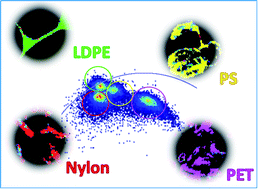Nile Red lifetime reveals microplastic identity†
Abstract
Microplastic pollution is recognized as a worldwide environmental problem. The increasing daily use and release of plastics into the environment have led to the accumulation of fragmented microplastics, with potentially awful consequences for the environment, and animal and human health. The detection and identification of microplastics are of utmost importance, but available methods are still limited. In this work, a new approach is presented for the analysis of microplastics based on hydrophobic fluorescence staining with Nile Red, using spectrally resolved confocal fluorescence microscopy and fluorescence lifetime imaging microscopy (FLIM). Significant differences were observed in the emission spectra and fluorescence lifetimes of the analyzed microplastics. Nile Red fluorescence shows determinable behavior based on the polymer matrix and provides a fingerprint for the identification of fragments from different types of plastics. Lifetime imaging coupled with phasor analysis constitutes a fast, robust, and straightforward method for mapping and identifying different microplastics within the same sample in an aquatic environment.



 Please wait while we load your content...
Please wait while we load your content...